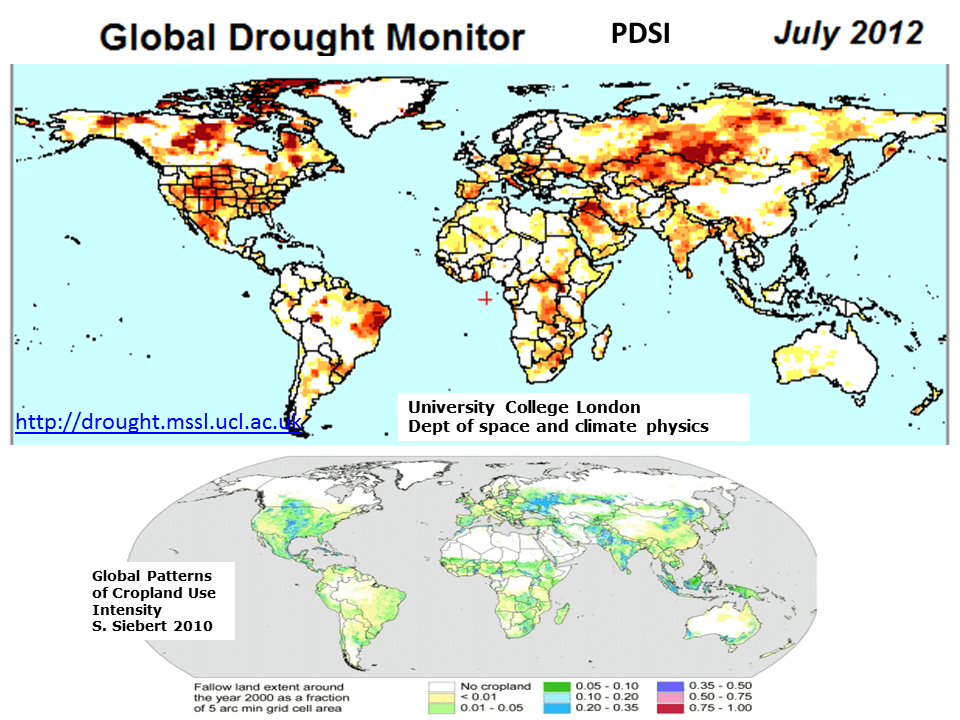紐約時報7日報導,根據8日將出刊的《科學(Science)》雜誌內容,美國俄勒岡州州立大學地球科學家 Shaun Marcott 等研究人員整理過去11,300年(幾乎涵蓋整個全新世、堪稱史上最細緻的全球氣溫重建)資料後發現,目前全球氣溫至少是4千年來最高水準,預估未來數十年可能超越上個冰河時期以來最高水準。
此前的研究顯示,過去一個世紀以來氣溫的快速飆高讓地球現在的溫度至少創1,500年來最高水準。上述最新研究結果顯示,當前地球暖化的獨特現象比原先推估的更加罕見。
彭博社報導,Marcott與哈佛大學學者的這項最新研究顯示,地球目前的溫度比上個冰河時期迄今多數(70-80%)時間都還要高。這份研究指出,依據「政府間氣候變遷小組( IPCC )」的氣候模型推估,全球氣溫將在2100年創下11,300年最高紀錄。
3月號彭博市場雜誌報導,隨著全球人口的快速增長(註:一年增加7,400萬人),水資源短缺的情形將會越來越嚴重。根據世界銀行贊助的《2030水資源集團》,以目前的成長速度來推算,2030年全球水資源需求量將較供給高出40%。
Global Temperature 大幅上揚
Annually, 2012 was the 10th warmest year since 1880. Only one year during the 21st Century was warmer than 2012.
NOAA National Climatic Data Center:
It was notably colder than average across much of Eurasia, western Canada, and Alaska. As shown by the temperature anomalies map above, December temperatures were more than 5°C (9°F) below the 1981–2010 average across central Asia, parts of western Canada, and eastern Alaska.
It was warmer than average across eastern North America, most of South America, southern Asia, Australia, and southern Greenland. Record warmth was observed in southern Brazil, parts of northwestern Australia, and some regions near the equator. The average December temperature was more than 5°C (9°F) above average in part of southeastern Greenland.
註: 2012 全球溫度大幅上揚狀況將在 2013 持續;
美大旱引發全球糧食系統震盪漲價悄然傳導至中國 2012
生在美國中西部的60年一遇的大旱不僅讓當地人飽受煎熬,也導致農作物的歉收減產。 作為世界頭號“糧倉”,美國農業歉收將直接考驗世界的糧食安全。
農業減產, 大部絕收
正當國人遭遇61年不遇的特大洪澇之際,在大洋彼岸的美國卻呈現出另一番景象:烈日當頭,土地干涸,河床崩裂,遍地死魚,小草枯黃,莊家渴死……居住在衣阿華州的華人女醫生孫文清告訴本報記者,而在如此炎熱高溫的天氣下,當地人很少出門,一般都待在屋里以逃避戶外的滾滾熱浪,並將空調溫度開到最低。 在鄉村,她親眼看到一些農民用收割機將不會再有收成的玉米剷平。 當地電視反複播放這樣的畫面,一位農民在枯黃的玉米地裡掰下一個玉米棒,剝開後裡面沒有一顆玉米粒。 另外,由於草坪無法生長,當地的除草機處於熱銷當中。
衣阿華州農業部氣象局公佈的數據顯示,僅6月份家庭用電量環比高出36%,同比高出35%。 當地空調和扇子賣得特別好,但一向受到美國人青睞的戶外用品卻無人問津。
這是一場被美國人戲稱為“史詩”的干旱。 據美國國家海洋和大氣管理局在其官網上發表報告稱,美國中西部地區正在遭受60年來最嚴重的干旱,旱情已經接近1956年大旱。 低緯度地區48個州中55%的土地面積都受到了乾旱影響。 衣阿華州農業部氣象局網站公佈的一份報告顯示,往年六七月是該州氣象最為活躍的月份,經常受到雨水伴隨颶風的襲擊,但今年卻反映出十分反常的安靜。 而作為美國和世界玉米和大豆的主產區,衣阿華州已被列為異常乾躁狀態,減產和作物優良率下降在所難免,因此推高了玉米和大豆的價格。
實際上,衣阿華州農作物歉收也給全美乃至世界糧食系統拉響了警報。 作為世界頭號“糧倉”,美國供應了接近35%的世界玉米和大豆。 世界糧食價格近期持續上揚,芝加哥期貨交易所(CBOT)玉米與黃豆價格已經持續幾週居高不下,玉米一個月來暴漲了30%,而黃豆期貨也攀升到四年新高。
美國農業部公佈的數據顯示,截至7月16日當週,美國玉米生長優良率為36%,大豆優良率為38%,而至7月29日的當週,又分別下降至24%和29 %。 而一年前,玉米和大豆的優良率均達到80%以上。 美國氣象學家唐·基尼預測,本月旱情仍將得不到緩解,作物等級將繼續下降。 截至7月29日,相關數據顯示,預期收成為“非常差”和“差”的大豆作物比重上升至37%,玉米作物的這一比重上升到48%,牧草和牧場的這一比重高達57 %。 “乾旱影響了美國88%的玉米,一半的大豆以及其他多種作物的產量。”據芝加哥期貨交易所(CBOT)數據顯示,國際玉米價格已從510美分/蒲式耳上漲至階段高點800美分/蒲式耳,大豆價格也出現階段高點1691。
路透社報導說,美國中西部地區旱情持續加劇引發了投資者對世界糧食供應前景的擔憂。 目前美國玉米出口占據著全球貿易量的一半以上。 玉米不僅是重要飼料也是重要澱粉來源。 據彭博分析師預測,到10月份,全球玉米儲量將下降4.2%,達到1.23億公噸,相當於52天的消費量,為1974年以來的最低。 而高盛的預測是,至9月份美國秋收之前,玉米價格將上漲9.6%至7美元/蒲式耳。 芝加哥穀物經紀公司Fintec Group Inc.的管理部主任Alberto Alvarez指出:“大旱必將導致玉米價格爆發式上漲。”而芝加哥商品交易所12月份交割的玉米期貨報價自6月中旬以來累計漲幅已經高達54%。
 |
| Drought in the world |
美國普渡大學農學家Tony Vyn的預測更為嚴重:“我們正在從危機走向災難。”他說:“大幅度減產已成定局,事實上大部分地區可能絕收。”
全球糧食系統震盪
乾旱還給美國畜牧業造成了災難性的影響。 當地媒體多次轉載引用的一個例子是,衣阿華州的奶農羅賓·馬科特飼養了45頭奶牛,但如今她不得不減少15頭出奶量,因為牧草大量枯死,沒有足夠的牧草她無法餵養全部的奶牛,而由於出奶量的減少導致銷售額的減少,致使她無力購買足夠的飼料替代品。 面對如此的惡性循環,羅賓·馬科特預計出奶量還會繼續減少,直至減少奶牛頭數。 實際上,衣阿華州三成以上的牧場在經營上都處於極度困難。
事實上,這場乾旱也影響了美國國內的食品價格。 據美國農業部日前發布預測稱,預計全年食品價格漲幅為2.5%-3.5%,明年的漲幅會升至4%-5%。 美國勞工部7月下旬公佈的數據也顯示,食品價格在6月份同上個月相比上漲了0.2%,與去年同期相比上漲了2.7%。 隨之而來的是全美消費者信心指數的一路下滑。 美國密歇根大學和路透社聯合發布的報告顯示,7月份美國消費者信心指數為72.3,比上個月降低了0.9,降至今年以來最低水平。
乾旱帶來的不僅僅是玉米減產的數量,而是對整個世界食物體系的影響。 國際糧食政策研究所高級研究員Liangzhi You指出,玉米和大豆在整個食物鏈上十分重要,因為它們還被用於飼養動物。 全世界不斷增長的肉類和蛋白質需求,讓許多國家更依賴從美國進口便宜的飼料。 美國農業部預計,來年牛肉和雞蛋的價格可能增長4%-5%,乳製品將增長3.5%-4.5%,豬肉將增長2.5%-3.5%。
全球性氣候異常也帶來了全球糧食系統的震盪。 世界銀行日前發布報告稱,受美國異常乾旱天氣,歐洲一些國家持續降雨,俄羅斯、印度等產糧國降雨不足等因素影響,國際糧價正在上漲,糧價波動造成了市場的不確定性,對糧食安全構成威脅。
U.S. Drought Monitor 美國旱象追蹤
Weather Summary: The past week featured generally dry conditions across most of the western half of the contiguous 48 states with a deep trough over the eastern half. The deep low-pressure system over the eastern half of the contiguous 48 states yielded widespread precipitation, with rainfall totals generally less than 3.0 inches from the Ohio Valley to the Northeast, and across portions of the Mid-Atlantic. The Pacific Northwest was another stormy region, with multiple reports of more than 4 inches of precipitation during the past week. Isolated reports of 0.5-1.5 inches of precipitation came in from stations across the Central Rockies. Elsewhere, precipitation amounts were less than 0.5 inch.
2012 Was Hot, Dry and Energy-Shifty in the U.S.
In the coming days, Circle of Blue will publish its review of 2012 and its preview of 2013. Our stories, photographs and infographics tell the tale in their own stellar way, but recent summary data from federal agencies chisel 2012’s epitaph in cold, hard numbers.
Yesterday the National Climatic Data Center confirmed what everyone knew to be true. Last year was the hottest in the 118-year historical record for the Lower 48 states. It was an outlier among outliers, a full degree Fahrenheit warmer than 1998, the former standard-bearer, and 3.3 degrees F warmer than the 20th century average.
Not only was it hot. It was dry too. Two states, Nebraska and Wyoming, set records for lowest rainfall. Eight others had a top-ten dry year.
Often partners in arms, the heat and aridity led to the worst drought in the U.S. since the 1950s. Since July, roughly three out of every five acres in the Lower 48 states have endured drought conditions.
Five out of every six counties — 83 percent — is designated a drought disaster area.
Scant rain and higher temperatures mean more evaporation, which has hit the Great Lakes. Lake Michigan dropped to a record-low level in December.
 |
| 2012 美國旱象嚴重, 將造成農產、水資源 ETF 成投資趨勢 |
Commodity prices rose, but natural gas prices continued to fall. The average national price of natural gas dropped 31 percent in 2012.
Power companies are sopping up the flood of cheap fuel, converting the nation’s stock of power plants from coal to gas. The Energy Information Administration, however, expects that trend to level off in the next few years.
What does 2013 bring? Weather-wise, more of the same, it seems. The three-month outlook from the National Oceanic and Atmospheric Administration forecasts persistent dry pattern over the heart of the country.
分析
- 預估全球農業與水資源將會在2013 三月後又有一波最棒的投資,要参考 currency ETF UUP 高點進場較佳;
- 2013 最佳投資點應該在超跌後轉強點,定額投資。
- 預估美國、中國今年將持續乾旱,又逢太陽能量輸出最大年;
- 投資可参考 農業 ETF ,選擇 JJA、DBA、PHO;
- 今年應該有乾旱蓋念股、ETF 投資機會;











沒有留言:
張貼留言